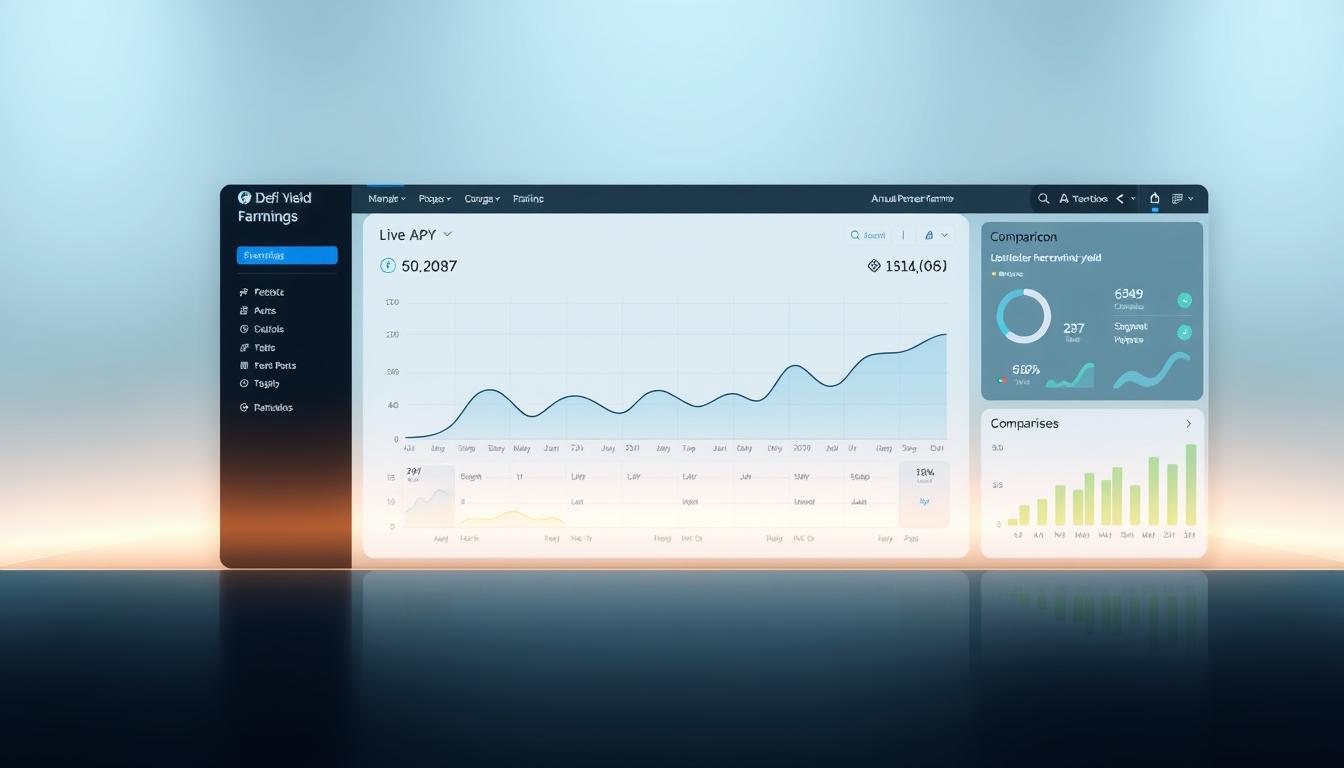Now Reading: DeFi yield farming calculator compare 50 platforms live APY
- 01
DeFi yield farming calculator compare 50 platforms live APY
DeFi yield farming calculator compare 50 platforms live APY

Navigating the world of decentralized finance can feel overwhelming. Investors face a sea of choices, each promising different returns. Finding the best option requires clear, up-to-date information.
Our new tool simplifies this process. It acts as a central hub for tracking annual percentage yields across the ecosystem. You can see data from major protocols like Lido, Rocket Pool, and EigenLayer.
The information updates continuously. This gives you a real-time view of the best opportunities for your crypto assets. The tool covers various strategies, from liquid staking to stable-yield protocols.
This calculator lets you compare over 50 different platforms side-by-side. It pulls live data from Ethereum, Solana, and Bitcoin-based solutions. This provides a complete picture of the current yield farming landscape.
You no longer need to visit dozens of individual websites. Our tool consolidates everything in one place. This saves you time and helps you make smarter, faster investment decisions in the defi space.
Key Takeaways
- A single tool provides live APY data from over 50 decentralized finance platforms.
- The calculator tracks major protocols, including liquid staking and restaking solutions.
- Data updates in real-time, ensuring you have the most current information.
- The comparison includes various yield sources like staking rewards and protocol incentives.
- It consolidates information from multiple blockchains, offering a comprehensive view.
- The tool eliminates the need for manual research across dozens of individual sites.
Introduction to DeFi Yield Farming and Live APY
The digital asset ecosystem offers various methods for investors to generate additional returns on their holdings. One popular approach involves participating in decentralized finance protocols that reward users for contributing resources.
This strategy allows crypto holders to put their idle assets to work. They can earn consistent income while maintaining exposure to their preferred digital currencies.
Defining Yield Farming and APY Concepts
Yield farming represents a core strategy in the decentralized finance space. Investors lock their cryptocurrency assets into smart contracts called liquidity pools.
These pools facilitate trading and other operations within defi protocols. Participants earn rewards proportional to their contribution.
The apy metric shows the annual percentage yield investors can expect. This figure accounts for compounding effects when rewards get reinvested.
Unlike simple interest rates, apy provides a more accurate picture of potential earnings. It reflects how returns can grow over time through reinvestment.
The Role of Live Data in DeFi
Real-time information plays a crucial role in decentralized finance strategies. Yield rates change constantly based on market conditions.
Factors like trading volume and total value locked affect potential returns. The number of participants also influences reward distribution.
Access to current data helps investors make informed decisions. They can identify the most promising opportunities for their digital assets.
Live information separates modern tools from static comparisons. Investors benefit from seeing actual market conditions rather than historical averages.
What is Yield Farming? Overview and Insights
Understanding yield farming begins with grasping the mechanics of liquidity provision in decentralized markets. This strategy allows cryptocurrency holders to earn passive income from their digital assets.
Mechanics of Liquidity Pools
Liquidity pools serve as the foundation for yield farming activities. These are smart contract-based reservoirs that hold paired digital assets.
When users deposit cryptocurrency pairs into a pool, they receive liquidity provider tokens. These tokens represent their share of the total liquidity.
Every trade executed through the pool generates trading fees. These fees get distributed to liquidity providers based on their contribution percentage.
Benefits and Risks for Investors
The primary benefit involves earning consistent rewards from trading activity. Some platforms have historically offered attractive returns during high-incentive periods.
However, investors face several significant risks. Impermanent loss occurs when token prices change relative to your initial deposit.
Smart contract vulnerabilities present another concern. Protocol bugs or exploits could potentially lead to fund losses.
Token price volatility and governance changes also affect reward stability. Early participants often capture higher returns before more capital enters the pool.
Comparison Article: Evaluating DeFi Platforms
When assessing different financial protocols, investors must consider multiple dimensions beyond just advertised percentage rates. A thorough evaluation framework examines total value locked, security audits, and withdrawal mechanics.
Liquid staking platforms like Lido and Rocket Pool dominate Ethereum staking. They offer 2.5%-5% returns with varying decentralization levels. Restaking services such as EigenLayer provide enhanced yields of 3%-8%.
Stable-yield protocols deliver dollar-denominated returns through sophisticated strategies. Ethena and Maple use delta-neutral positions and lending markets. Chain-specific options like Solana’s Jito offer MEV-boosted rewards.
User experience varies significantly across these platforms. Some enable instant withdrawals through liquidity pools. Others impose unbonding periods from one to seven days.
The evaluation process must distinguish sustainable yield sources from temporary incentives. Understanding whether DeFi yield farming is more profitable requires analyzing underlying mechanisms. Validator rewards and trading fees typically offer more stability than token emissions.
Each protocol serves different investor needs in the decentralized finance market. The right choice depends on individual risk tolerance and investment goals.
DeFi yield farming calculator compare 50 platforms live APY
Our tool gathers information automatically from multiple sources to give you a complete picture. It connects directly to protocol interfaces and on-chain data streams. This ensures the numbers you see reflect the current market situation.

How the Calculator Works
You start by entering your preferences. Tell the tool what kind of digital assets you hold and how much you want to invest. It also considers your comfort with risk and how quickly you might need to access your funds.
Based on your inputs, the system filters through all available options. It then presents a ranked list of the most suitable protocols for your specific situation. This personalized approach saves you significant research time.
The system clearly labels different kinds of rewards. You can see the base rate a protocol offers from its core operations. It also shows any extra, variable incentives that might change over time.
Interpreting Live APY Data
Looking at the annual percentage yield number is just the beginning. It’s crucial to understand what makes up that figure. Some returns come from stable sources like validator rewards, while others depend on temporary token distributions.
The tool provides essential context beyond the headline percentage. You can see the total value locked in a protocol, which hints at its stability. Audit status and withdrawal periods are also displayed for a full assessment.
It’s important to distinguish between gross and net potential earnings. The tool estimates your actual take-home returns after accounting for potential fees and other costs. This gives a more realistic expectation of your profits.
Additional metrics, like how widely a token is distributed among holders, offer insights into community strength. This helps you gauge the long-term health of a protocol beyond short-term yield numbers.
Analyzing APY Ranges and Performance Metrics
Understanding the true value of advertised returns requires digging into how those numbers are actually generated. Different protocols use distinct calculation methods that affect the final annual percentage yield figures.
Understanding APY Calculation Methods
Liquid staking protocols build their apy from validator rewards combined with transaction fees. Lending platforms derive their yield from interest payments minus operational costs.
The frequency of compounding significantly impacts realized returns. Some systems automatically reinvest earnings daily, while others require manual action. This friction can reduce effective earnings for passive participants.
Key Performance Indicators for Farms
Beyond headline percentages, several metrics reveal protocol health. Total value locked stability indicates investor confidence. Fee generation relative to size shows whether rewards are organic or subsidized.
Sustainable earnings come from durable sources like trading fees and lending spreads. Temporary incentives like token emissions often create inflated apys that decline over time.
| Protocol | Asset | APY Range | Primary Yield Source |
|---|---|---|---|
| Lido | stETH | 2.56%-3.00% | Validator Rewards |
| Rocket Pool | rETH | 2.0%-3.5% | Staking + MEV Fees |
| EigenLayer | Restaking | 1%-8% | AVS Incentives |
| Ethena | sUSDe | 4.72%-10% | Carry Trades |
| Pendle | YT tokens | 10%-600%+ | Future Yield Trading |
The wide range within single platforms reflects different strategies and risk levels. Higher percentages typically correlate with newer protocols or complex farming approaches that carry additional uncertainty.
Examining Token Metrics and Holder Count Studies
Holder count metrics serve as a vital indicator of a token’s adoption and decentralization level. These numbers reveal how widely distributed a digital asset is across its community.

Projects with higher holder counts typically demonstrate broader support networks. They also show more diverse participation across the market.
Insights into Holder Distribution
Recent launches provide compelling case studies. Token Metrics Live captured 876 holders within its first 22 hours. This rapid adoption stemmed from seven years of established crypto content experience.
Other projects show different distribution patterns. New XAI gork leads with 15,687 holders, followed closely by Chill House at 16,291. The Spirit of Gambling (Tokabu) maintains 10,605 holders.
| Token Project | Holder Count | Market Cap | Launch Characteristics |
|---|---|---|---|
| Token Metrics Live | 876 | $291.7K ATH | Rapid launch (22 hours) |
| New XAI gork | 15,687 | Not specified | Established project |
| Chill House | 16,291 | Not specified | Broad distribution |
| Tokabu | 10,605 | $7.2M | Community-focused |
Evaluating Community Engagement
Raw holder numbers only tell part of the story. True community engagement measures how active these users are beyond simply holding the token.
Effective metrics include governance participation rates and social media interactions. A platform with high engagement typically shows stronger long-term potential.
Distribution analysis helps distinguish between concentrated and broad holder bases. Projects exceeding 10,000 holders often demonstrate organic community building rather than pure speculation.
Live Data Integration and Methodological Approaches
The reliability of any analytical tool depends heavily on its underlying data collection methodology. Our system employs a multi-layered approach to ensure information accuracy across different financial networks.
We prioritize on-chain data as the primary source of truth. This information comes directly from blockchain explorers and provides the most reliable foundation for analysis.
Data Sources and Verification
Our methodology uses multiple independent sources for cross-verification. This includes direct connections to protocol APIs and established analytics platforms.
Each data point undergoes rigorous verification before inclusion. We check contract addresses against official documentation and monitor for anomalies.
Security audits from reputable firms like Certora and ChainSecurity provide additional confidence. These reviews cover smart contract safety and operational integrity.
Cross-chain aggregation presents technical challenges that require specialized solutions. Different blockchain architectures demand customized integration methods while maintaining consistency.
Transparency remains a core principle throughout our process. We clearly timestamp all information and disclose any estimation methods used when exact figures are unavailable.
This comprehensive approach ensures users receive accurate, current information from trustworthy sources. The system continuously validates data quality across all integrated protocol networks.
Risk Assessment and Reward Analysis on Platforms
Before committing capital to any financial protocol, a thorough examination of potential threats is essential for long-term success. Investors must weigh advertised returns against the probability of various losses.
A systematic approach categorizes different risks into clear buckets. This framework helps evaluate each platform objectively.
Identifying Market and Contract Risks
Smart contract vulnerabilities represent the most severe potential losses. Historical exploits have demonstrated how code flaws can drain user assets rapidly.
Market risks affect different protocols uniquely. Liquid staking tokens face de-peg events during stress periods.

Liquidity provider positions suffer from impermanent loss when token prices diverge. These market dynamics can significantly reduce actual returns.
| Risk Category | Primary Characteristics | Platform Examples |
|---|---|---|
| Smart Contract Risk | Code vulnerabilities, potential exploits | All decentralized protocols |
| Market Risk | Price volatility, liquidity crunches | Liquid staking, LP positions |
| Operational Risk | Oracle failures, governance attacks | Lending protocols, derivatives |
| External Risk | Regulatory changes, counterparty defaults | Stable-yield strategies |
Protocol-specific risks like slashing affect validator-based systems. Withdrawal delays create liquidity risks during high demand periods.
True reward analysis must account for these potential losses. A comprehensive security assessment protects investor assets effectively.
Yield Farming Versus Staking: A Comparative Review
Investors often face a choice between two primary strategies for generating crypto income. Each approach serves different objectives and risk tolerances.
The fundamental mechanisms create distinct operational requirements. Staking involves securing blockchain networks through validator participation.
Participants receive consistent rewards for maintaining network integrity.
Differences in Mechanisms and Returns
Yield farming operates through liquidity provision to decentralized exchanges. Users contribute assets to automated market maker pools.
This activity generates fees from trading volume rather than block validation. The returns fluctuate based on market activity.
Staking follows a more predictable reward model. Network participants earn fixed percentages for validating transactions.
This creates stability but limits potential upside compared to dynamic farming approaches.
Liquidity characteristics represent another critical distinction. Many yield farming positions allow instant exit strategies.
Staking typically requires unbonding periods that delay access to funds. This affects capital flexibility for active investors.
Risk profiles diverge significantly between these methods. Staking faces validator slashing risks but generally offers greater security.
Farming encounters impermanent loss and smart contract vulnerabilities. These factors influence overall potential returns.
The choice ultimately depends on investment timeframe and risk appetite. Short-term strategies may favor farming’s higher potential yields.
Long-term holders often prefer staking’s simplicity and consistent reward model.
Understanding DeFi Staking and Restaking Protocols
Capital efficiency represents a critical advancement in how digital assets can generate returns without sacrificing liquidity. Modern staking solutions have evolved to address this challenge directly.

These protocols transform how users interact with blockchain networks. They unlock new possibilities for optimizing cryptocurrency holdings.
Core Benefits of Liquid Staking
Liquid staking revolutionized participation in network security. Users receive tradable tokens representing their staked assets.
This approach maintains full exposure to rewards while preserving capital flexibility. The resulting tokens integrate seamlessly across various decentralized applications.
Deep liquidity pools ensure these tokens remain easily tradable. This eliminates the capital lock-up period common in traditional staking methods.
Restaking and Its Added Incentives
Restaking extends the utility of already staked assets. It allows users to secure additional services beyond basic network validation.
This creates layered rewards from multiple sources. However, it introduces correlated risk factors that require careful consideration.
The protocol architecture enables capital to work across several security functions simultaneously. This maximizes efficiency while maintaining network participation.
Reviewing Top Platforms for Staking and Yield Farming
Evaluating different staking and farming services requires careful consideration of multiple factors. Each platform offers unique combinations of returns, security measures, and user experiences.
Platform Highlights and User Metrics
DeFi Swap stands out with its high potential returns, offering up to 75% for long-term commitments. This newer service on Binance Smart Chain appeals to risk-tolerant users seeking maximum gains.
AQRU provides a contrasting approach with stablecoin yields around 12%. The platform emphasizes security with insurance coverage and flexible withdrawal options.
Established services like Coinbase serve beginners with simplified interfaces and educational resources. While returns may be lower, regulatory compliance and user support are significant advantages.
Crypto.com rewards loyal users with enhanced rates through its tiered staking system. This approach encourages long-term platform engagement among crypto enthusiasts.
Fee structures vary significantly across these services. Some charge fixed withdrawal costs while others use percentage-based models. These fees directly impact net returns for users.
Each platform serves different investor profiles based on risk tolerance and experience level. Understanding these distinctions helps users select the most suitable service for their needs.
Advanced Yield Farming Strategies and Tools
Moving beyond basic approaches requires implementing multi-layered strategies that maximize capital efficiency. Sophisticated techniques can significantly enhance returns while managing risks effectively.
These advanced methods transform simple participation into sophisticated capital deployment. Investors can access higher potential rewards through carefully structured approaches.
Automation and Compounding Techniques
Auto-compounding vaults represent a powerful automation tool. They automatically reinvest earnings to maximize the compounding effect.
This eliminates manual work and reduces transaction costs. Smaller positions benefit greatly from this automated approach.
Leverage loops create amplified exposure through borrowed capital. Users can multiply their base returns using this sophisticated strategy.
Yield tokenization enables advanced rate trading opportunities. Platforms split assets into fixed and variable rate components.
Cross-chain aggregation captures the best opportunities across multiple networks. This approach requires careful risk management but offers diversified rewards.
Proper tooling is essential for implementing these complex strategies. Portfolio trackers and monitoring systems help maintain optimal positions across different pools.
Community Insights and Market Trends in DeFi
The maturation of decentralized finance is evident through evolving user behavior and community metrics. Successful projects now build on foundations of consistent value delivery rather than pure speculation.
Token Metrics Live demonstrates this shift perfectly. With seven years of consistent crypto content before launching, it attracted 876 holders in just 22 hours. This shows how established credibility drives rapid adoption.
Current market trends reveal investors prioritizing risk-adjusted returns over highest percentages. They demand audit transparency and clear sustainability models. This represents significant development in user sophistication.
Community engagement metrics extend beyond simple holder counts. Quality indicators like message frequency and watch time measure genuine stickiness. Projects with high engagement sustain momentum longer than speculative ones.
Development trends favor modular protocols that integrate across ecosystems. Liquid staking tokens succeed through extensive integrations creating network effects. This market evolution benefits all users.
Adoption curves differ between organic growth projects and rapid-launch tokens. The former shows steady accumulation over 5-10 months. The latter captures early audiences through existing communities.
Trading volume analysis confirms that broad community distribution serves as a leading indicator. Projects combining engagement with growing holder counts maintain momentum effectively. This insight helps identify sustainable opportunities in the defi space.
Future Trends and Developments in DeFi Yield Farming
Looking ahead reveals exciting transformations in how digital assets generate income. The decentralized finance space continues to evolve with groundbreaking innovations that will reshape investment strategies.
Major developments are expanding beyond traditional boundaries. Restaking primitives now extend to multi-chain environments, allowing diverse assets to secure additional networks.
Technological Innovations on the Horizon
Distributed Validator Technology enhances staking resilience by splitting responsibilities across multiple nodes. This reduces single points of failure while enabling broader participation.
Bitcoin staking represents a frontier development with protocols enabling previously idle BTC to secure proof-of-stake networks. This potentially unlocks yields on trillions in dormant holdings.
Yield tokenization through advanced platforms brings traditional fixed-income concepts to decentralized finance. Sophisticated investors increasingly demand instruments for hedging interest rate risk.
Regulatory and Market Outlook
Regulatory frameworks worldwide are establishing clearer guidelines for decentralized protocols. This provides legal clarity that could enable institutional capital inflows.
The market outlook suggests consolidation around battle-tested protocols with strong security records. Newer platforms must differentiate through specialized strategies rather than competing solely on returns.
Cross-chain interoperability improvements will enable seamless activities across multiple blockchain environments. Users won’t need to manage separate wallets and strategies per chain.
Insurance protocol maturation reduces systematic risk by providing affordable coverage. This transforms activities from uninsurable to quantifiable risk management.
Conclusion
Making smart choices in the digital finance space requires access to current, reliable information. Our comparison tool provides this essential data across numerous services, helping you identify the best opportunities for your investment goals.
Different approaches offer varying levels of potential income and risk. Conservative strategies provide stable returns that significantly outperform traditional savings options. More aggressive methods can generate higher percentages but demand careful risk assessment.
Successful participation requires balancing reward potential with capital protection. Always prioritize security audits and sustainable yield sources over temporary high percentages. Diversification across multiple services helps manage risk effectively.
The landscape continues evolving with new innovations that create additional income streams. Staying informed and adapting your strategy ensures long-term success in generating meaningful returns on your digital assets.
FAQ
What is the main purpose of a yield farming calculator?
The primary purpose is to help investors estimate potential earnings from providing liquidity. It uses live data to calculate projected returns, including rewards and trading fees, while factoring in costs like gas fees and impermanent loss.
How does live APY data differ from projected APY?
Live APY reflects real-time returns based on current network activity and token prices. Projected APY is often an estimate that may not account for sudden market shifts or changes in protocol incentives, making live data more accurate for decision-making.
What are the biggest risks associated with yield farming?
The significant risks include smart contract vulnerabilities, impermanent loss from asset price changes, and sudden shifts in tokenomics or protocol incentives. Market volatility can also drastically affect the value of rewards earned.
How is yield farming different from traditional staking?
Yield farming typically involves providing assets to liquidity pools to earn fees and token rewards, which is more active and complex. Traditional staking usually involves locking tokens to support a blockchain’s security and operations for a simpler, often lower, return.
What should I look for when comparing different platforms?
Key factors include the platform’s security audits, total value locked (TVL), the transparency of its fee structure, the sustainability of its reward emissions, and the depth of its liquidity pools. Strong community engagement is also a positive indicator.
Can you explain what impermanent loss is?
Impermanent loss occurs when the price of assets you deposit into a liquidity pool changes compared to when you deposited them. This divergence can result in a lower dollar value than if you had simply held the assets, though it is “impermanent” until you withdraw.
What is liquid staking and how does it work?
Liquid staking allows you to stake your tokens and receive a liquid staking token (LST) in return. This LST represents your staked assets and can be used elsewhere in the ecosystem, like in lending or providing liquidity, enabling you to earn staking rewards and additional yields simultaneously.












